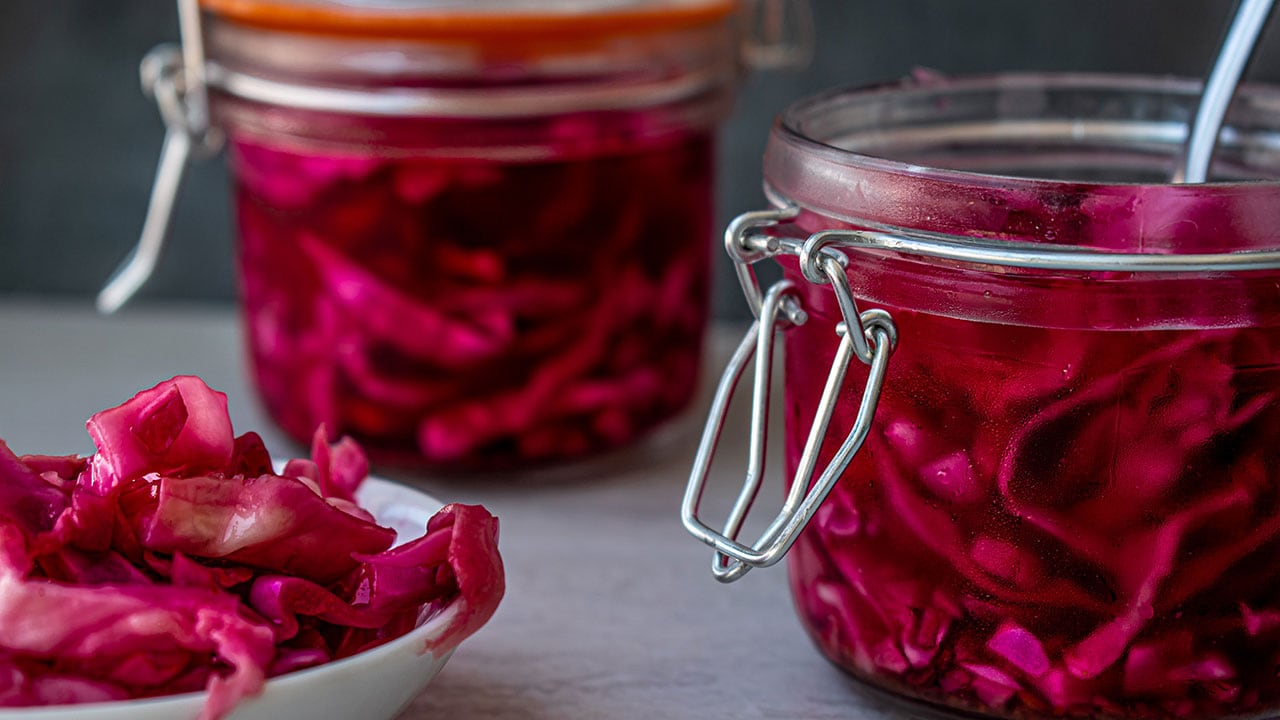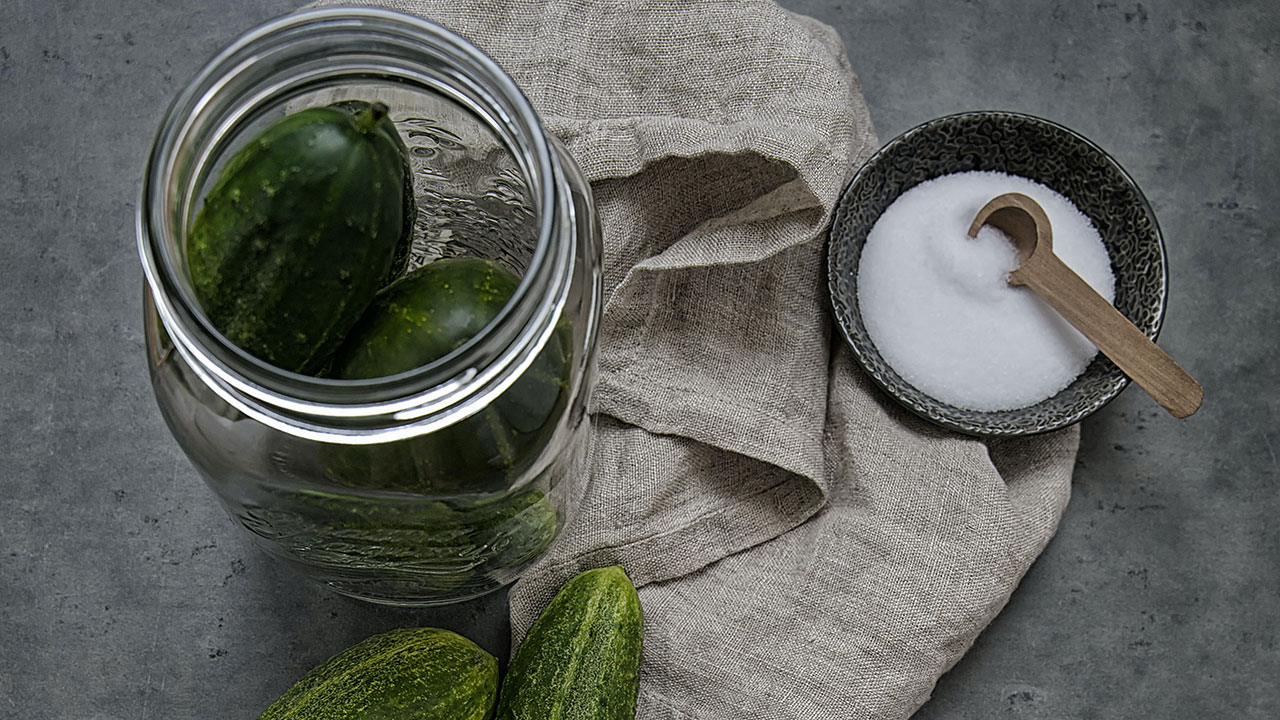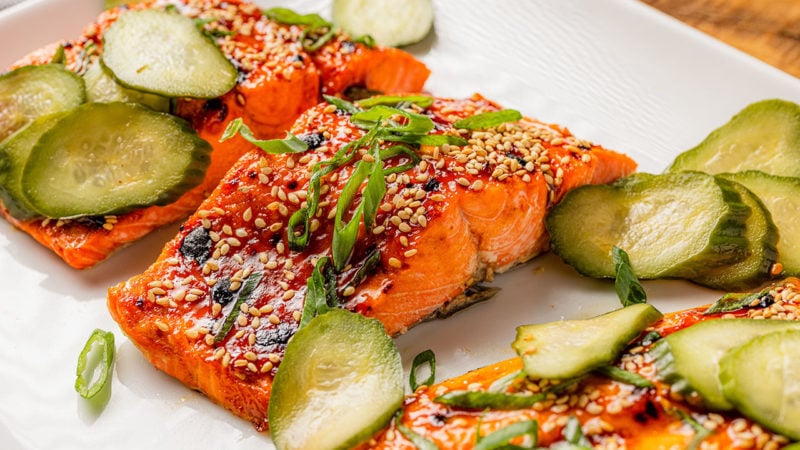Last Updated on March 26, 2024
Have you ever wondered what goes into making that jar of pickles in the fridge? Perhaps you’re curious how kimchi develops such a deep umami flavor? Then you may want to learn how to ferment and pickle vegetables at home.
This guide breaks down each process. You’ll get instructions on how to ferment and pickle vegetables as well as quick tips on how to use them in recipes.
Quick Pickling vs. Fermenting
If you’re not familiar with the world of fermenting and pickling, you might be surprised to know there are quite a few differences between the two.
Pickling is a food preservation method that’s been in practice since ancient Mesopotamia. There are a couple of different ways to pickle foods, primarily by anaerobic fermentation in either brine or vinegar. Most pickles you’ll find in the store are pickled by canning produce in vinegar, often using a water bath canning method.
That method will yield you very shelf-stable pickled vegetables, but it’s a bit more technical and involved. If you’re looking for something you can easily do in your own kitchen, quick pickling, also called refrigerator pickling, might be a good option. This method simply calls for brining vegetables in the fridge for a few days.
Fermented vegetables can come in a few different forms, too. First, there’s natural or “wild” fermentation, which involves salting vegetables with a high water content to draw the water out and create a natural brine. You’ll see this with ferments like sauerkraut and kimchi.
Then, there are fermented vegetables made in a fermentation vessel, like a jar fitted with pickling weights (which keep the veggies submerged in the fermentation liquid) and an airlock lid. Depending on the ferment, you might use salt, whey, or a starter culture to get started.
The Best Vegetables for Pickling and Fermenting

The truth is, you can pickle or ferment just about any vegetable. It all depends on your personal taste preferences. Both pickling and fermenting will add a salty, acidic, and complex flavor to any fresh produce you choose.
If you’re looking for a jumping-off point, here are some popular vegetables for pickling and fermenting:
- Cucumbers
- Cauliflower
- Green beans
- Jalapeños
- Onions
- Beets
- Radishes
- Garlic
- Cabbage
- Ginger
- Carrots
- Zucchini
Try Adding These Herbs and Spices for Zingy Flavor
It’s not just the vegetables that can add flavor to your pickles and ferments. Feel free to have fun with fresh herbs and spices, too. Here are a few seasonings to consider:
- Herbs (dried or fresh): dill, oregano, marjoram, rosemary, thyme, bay leaves
- Spices: store-bought pickling spice (to keep it easy), peppercorns, red pepper flakes, mustard seed, coriander, allspice berries
- Peeled ginger
- Sliced garlic cloves
- Sugar
How to Pickle Vegetables

If you’d like to try pickling at home, quick pickling is the most accessible method. You can enjoy pickles in just 48 hours with this method. Note, quick pickled vegetables won’t develop as complex of flavors as fermented veggies, but they’re still plenty delicious.
Here’s how to pickle vegetables at home:
- Wash your equipment: You’ll need a couple of glass jars, washed and dried thoroughly.
- Prep your veggies: Opt for fresh veggies for the best results. Prepare your vegetables however you’d like. You can slice cucumbers into spears for dill pickle spears, or into rounds for perfect hamburger slices. The same goes for carrots and zucchini. Experiment with cuts and textures each time to figure out what you like best.
- Make your brine: Here, you’d be better off following a recipe. The Kitchn offers a great one. Essentially, a quick pickle brine will consist of equal parts vinegar and water, along with some salt and even sugar if you’d like. You’ll make it in a saucepan on the stove.
- Fill up your jars: Add your preferred herbs and spices, followed by your vegetables. Pour in your brine. Leave a ½ inch of space from the top of the jar to the top of the vegetables.
- Tap to remove air bubbles: Gently tap your jars against the counter to remove any air bubbles.
- Seal and refrigerate: All that’s left to do is to seal your jars, allow them to cool, and refrigerate them for at least 48 hours before digging in.
How to Ferment Vegetables
When it comes to fermented vegetables, there are a few different methods. As we covered before, you can do a natural fermentation by salting vegetables like cabbage and allowing them to create their own brine. Or, you can ferment vegetables in a vessel with an airlock.
Here are a few guidelines for getting started with fermenting vegetables:
- Gather your equipment: You’ll need some special equipment for most at-home ferments. This might look like a glass jar, an airlock lid, and pickle weights that hold your veggies down to keep them submerged in their fermentation liquid. Conveniently, some companies sell at-home fermentation kits that deliver everything you need to get started.
- Decide on your fermentation method: If you’re fermenting veggies for the first time, you should start with a tried-and-true recipe. Here’s a yummy recipe for simple kimchi, or a simple recipe for lacto-fermented garlic cloves. Whichever recipe you decide to make, pay attention to the ingredient you’re using for fermentation. It will probably be salt, whey, or starter culture.
- Know when to move your veggies to the fridge: Most ferments start out at room temperature, using the warmth to culture the veggies and develop flavor (along with beneficial bacteria). If you’ve never fermented anything before, it can be difficult to know when to move your ferments to the fridge for cold storage. Here’s a few tell-tale signs that they’re ready (learn more over at Cultures for Health):
-
- You notice bubbling or a slight carbonated flavor
- There’s a distinctly sour aroma (not spoiled or rotten!)
- It has a tangy, fermented flavor
How to Use Your Pickled and Fermented Vegetables

You’ve made some pickles or ferments. Yum! Here are a few delicious ways to use them in recipes:
- Add pickled carrots, green beans, or zucchini to a steak tip salad
- Use kimchi to liven up ground pork fried rice and spicy chicken larb
- Add spice to these lobster tacos with some pickled jalapeños
- Add crunch to our easy fajita pizza with pickled onions
- Use your own homemade sauerkraut in our leftover corned beef Reuben recipe
- Add homemade pickles for a to-die-for bacon cheeseburger
Now that you know how to ferment and pickle vegetables, it’s time to experiment and create something really tasty. No matter which vegetable or method you choose, you’re in for some tangy, acidic, and complex flavors that will enhance any dish.



